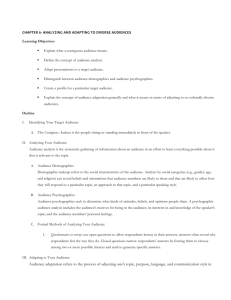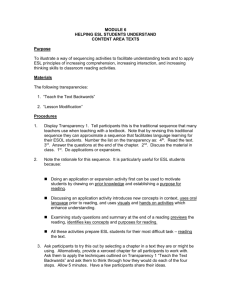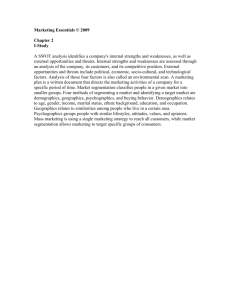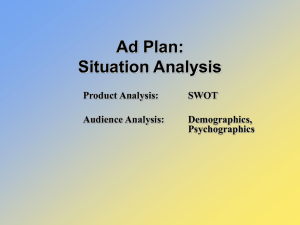Marketing - Pompton Lakes School District
advertisement
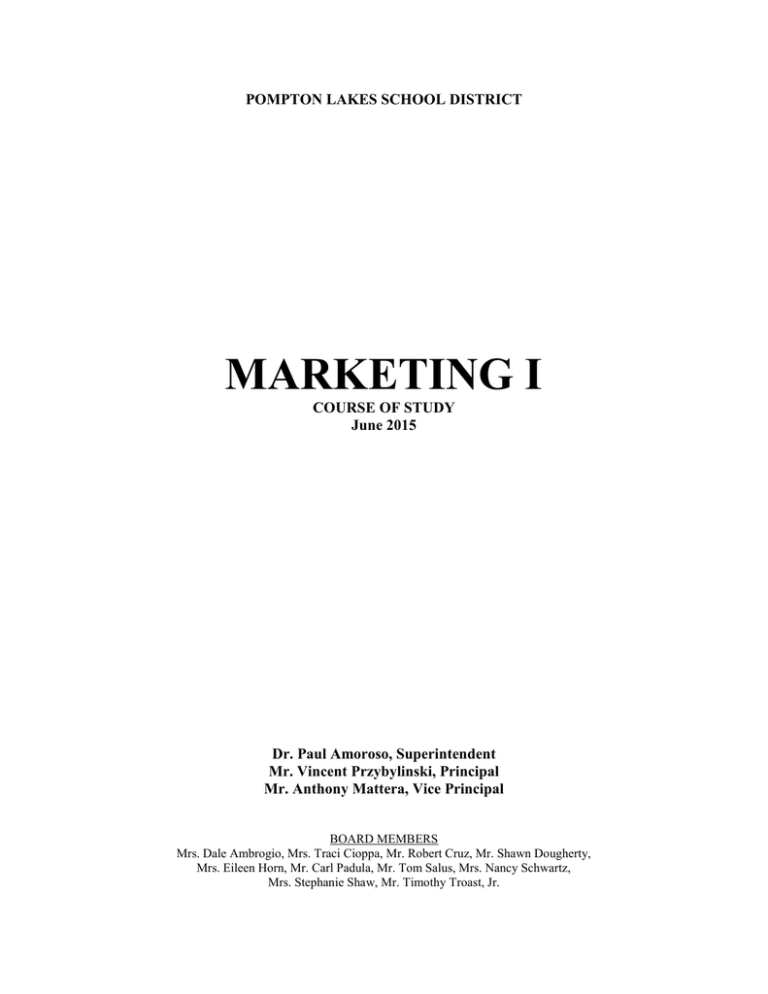
POMPTON LAKES SCHOOL DISTRICT MARKETING I COURSE OF STUDY June 2015 Dr. Paul Amoroso, Superintendent Mr. Vincent Przybylinski, Principal Mr. Anthony Mattera, Vice Principal BOARD MEMBERS Mrs. Dale Ambrogio, Mrs. Traci Cioppa, Mr. Robert Cruz, Mr. Shawn Dougherty, Mrs. Eileen Horn, Mr. Carl Padula, Mr. Tom Salus, Mrs. Nancy Schwartz, Mrs. Stephanie Shaw, Mr. Timothy Troast, Jr. Unit Overview Content Area: Marketing I Unit Title: Intro to Basic Marketing Target Course/Grade Level: Full Year Marketing Course Grade 11, 12 Unit Summary: This unit is designed to introduce students to the basic principles and importance of marketing. Primary interdisciplinary connections: Economics, psychology, and marketing 21st century themes: The importance of marketing and the implementation of the 7 marketing functions. Unit Rationale: Students to learn introduction to Marketing Principles. Learning Targets Standards 1.1 Recognize the role of marketing in the U.S. economy. 1.2 Understand how marketing meets consumer and business needs. 1.3 Learn the marketing activities in business. 1.4 Identify the ethical responsibilities of business. 1.5 Learn how supply and demand is the basis for our free economies success. Content Statements CPI # Cumulative Progress Indicator (CPI) 9.4.12.N.16 Develop and interpret tables, charts, and figures. 9.4.12.N.41 Demonstrate knowledge of strategies and systems for marketing activities. 9.4.12.N.(1).3 Analyze the concepts marketers use to target specific audiences. 9.4.12.N.(4).10 Manage marketing information to make business decisions. 9.4.12.N.(5).3 Learn fundamental economic principles and use them to see the impact on business operations and merchandise decisions. 9.4.12.N.6 Apply sociological knowledge of group behavior to understand consumer decision making. 9.4.12.N.(1).11 Analyze the concepts and strategies marketers use to determine and adjust prices for marketing communication. Unit Essential Questions Unit Enduring Understandings What are the 3 basic parts of marketing definition? What are elements of exchange? What are the 7 marketing functions and how does each play an integral part in our economy and business decisions? What is the relationship between marketing and society? How does this law of supply and demand affect consumer costs? Activities, manufacturer, and consumer keys to understand marketing. There are needs for both producers and consumers. Marketing functions are 1)Selling 2)Finance 3)Promotion 4)Distribution 5)Product Management 6)Pricing 7)Market Research Marketers and consumers need each other to satisfy new and advanced marketing techniques. Unit Learning Targets Students will ... Learn full definition of marketing. Learn in detail how each of the 7 marketing functions is critical to our economy and consumer satisfaction. Learn how satisfactory exchange is such a key element in the relationship between business and consumer. Be able to understand how new advancements in marketing techniques affect our society. Learn how to design supply demand graphs Understand how prices are decided in a free market society Evidence of Learning Summative Assessment (6 Weeks) Students have successfully demonstrated the knowledge of basic marketing, the 7 marketing functions, and the laws of supply and demand. Equipment needed: Books, charts, internet, and newspapers. Teacher Resources: Internet, books, business professionals, and projects. Formative Assessments Lesson Plans Lesson Lesson 1 Intro. to Marketing Lesson 2 Exchanges Lesson 3 7 Marketing Functions Lesson 4 Laws of Supply and Demand Lesson 5 Marketing effects on consumers and society Teacher Notes: Timeframe 1 Week 1 Week 2 Weeks 1 Week 1 Week Students will be required to manage their time efficiently due to shortage of computers. Students must learn which web-sites to use for success in this unit. Curriculum Development Resources Add new web-sites and periodicals. Unit Overview Content Area: Marketing I Unit Title: History of Marketing and the Marketing Concept and Economies of the World Target Course/Grade Level: Full Year Marketing Course Grade 11, 12 Unit Summary: This unit is designed to introduce students to economies of the world. The marketing concept and a history of marketing in America. Primary interdisciplinary connections: Marketing, Math, and History 21st century themes: History of marketing and the importance of the marketing concept. Unit Rationale: It is extremely important that students can relate marketing history with today’s marketing concept. Learning Targets Standards 1.6 Recognize how marketing has evolved from colonial problems until present day. 1.7 Understand the different economies in the world. 1.8 Realize the magnitude that the marketing concept has had on today’s economy. Content Statements CPI # 9.4.12.N.7 Cumulative Progress Indicator (CPI) Apply psychological knowledge of individual behavior s to understand consumer motivation. 9.4.12.N.(4).8 Employ concepts used to determine and target select audiences in order to have merchandising activities. 9.4.12.N.(4).10 Manage marketing information to make business decisions. 9.4.12.N.(5).10 Understand fundamental economic principles and use them to see the impact on business operations and merchandise decisions. 9.4.12.N.(1).3 Analyze the concepts and strategies historically used to determine and target communications to specific consumers. 9.4.12.N.(6).1 Gather, access, synthesize, evaluate and disseminate information to learn from marketing in the past. Unit Essential Questions Unit Enduring Understandings What are the 3 basic historical marketing periods? What caused the need for marketing to grow past 1900? How has modern day business relied on marketing to exist and succeed? How has the marketing concepts enabled all forms of business to succeed? How do the 3 basic world economies relate to each other and what distinguishes one from another? How has a free market economy led to the greatness of America? Colonial, industrial, revolution, and modern. Competition in the beginning of the 1900’s brought about modern day marketing. No business can succeed in today’s competitive environment. Fulfilling the needs of today’s consumers. Free enterprise, socialism, and communism. Freedom of choice, open markets, and competition are the basis for our market economy today. Unit Learning Targets Students will ... Learn the importance of the marketing concept and how it is so important for business success. Understand how our history has caused marketing to evolve to where it is today. Learn how different world economies operate and their effect on society. Learn how Keynsian and Friendman economic policies have played a role in our economy over the years. Learn how the U.S. administrations have implemented certain economic policies and where we stand today. Evidence of Learning Summative Assessment (3 Weeks) Students have successfully demonstrated the knowledge of the marketing concept, history of marketing in America, and the world economic systems. Equipment needed: Internet, overhead, charts, and newspapers. Teacher Resources: Internet, historical American articles, magazines, and texts. Formative Assessments Lesson Plans Lesson Lesson 1 The Marketing concept Lesson 2 History of Marketing and World Economies Teacher Notes: Timeframe 1 Week 1 Week Students will be required to manage their time efficiently due to shortage of computers. Students must learn which web-sites to use for success in this unit. Curriculum Development Resources Add new web-sites and periodicals. Unit Overview Content Area: Marketing I Unit Title: Demographics, Target Markets, Psychographics, and their relationship to each other. Target Course/Grade Level: Full Year Marketing Course Grade 11, 12 Unit Summary: This unit is designed to introduce students to companies’ successful marketing strategies. Use demographics, psychographics, and target markets to reach their goals. Primary interdisciplinary connections: Math, economics, psychology, and business. 21st century themes: The use of detailed target audiences and how they are needed today to implement successful marketing plans. Unit Rationale: To learn marketing, students must understand that knowledge of which companies target markets are used to be successful. Learning Targets Standards 1.9 Learn how to choose target markets. 1.10 Learn how demographics relate to psychographics. 1.11 Understand the integral parts of successful business plans. Content Statements CPI # 9.4.12.N.6 Cumulative Progress Indicator (CPI) Apply sociological knowledge of group behavior to understand consumer decision making. 9.4.12.N.(3).3 Employ concepts, tools, strategies, and systems used to access and maintain and disseminate information in order to assist business decision making. 9.4.12.N.(1).3 Analyze the concepts and strategies marketers use to determine and target marketing communications strategies to specific audiences. 9.4.12.N.(1).4 Research the concepts, systems, and tools marketers used when making decisions to gather evaluate, and disseminate marketing information. 9.4.12.N.(5).8 Employ concepts and strategies used to determine and target select audiences in order to use merchandising activities. Unit Essential Questions Unit Enduring Understandings What is the marketing concept? Fulfill customer needs. Why is the marketing concept a partner A must to determine your market needs. with success in business? Describes your target market. What are demographics? Study of buying behavior. What are psychographics? Who companies select as their audiences. What are target markets? Determine needs and implement the How can a company achieve a successful marketing concept. marketing plan? Must implement your marketing concept into Why do most businesses fail? business plans. Unit Learning Targets Students will ... Learn definition of marketing concept. Understand how implementation of the marketing concept is so vital to a company’s success. Learn how target markets are selected. Understand how demographics make up a target market. Learn how psychographics explain why consumers buy the way they do. Evidence of Learning Summative Assessment (3 Weeks) Students have successfully learned the meaning of the marketing concept and its use in business. For success and also understand how target markets are dependent upon a knowledge of demographics and psychographics. Equipment needed: Internet, overhead, charts, and newspapers. Teacher Resources: Internet, text, past business records and internet. Formative Assessments Lesson Plans Lesson Lesson 1 Marketing target markets Lesson 2 Psychographics/Demographics Lesson 3 Business Plans Teacher Notes: Timeframe 1 Week 1 Week 1 Week Students will be required to manage their time efficiently due to shortage of computers. Students must learn which web-sites to use for success in this unit. Curriculum Development Resources Add new web-sites and periodicals. Unit Overview Content Area: Marketing I Unit Title: Establishing Your Marketing Strategy-Using the 4 P’s Target Course/Grade Level: Full Year Marketing Course Grade 11, 12 Unit Summary: This unit is designed to initiate students to all companies Marketing Strategy by successfully implementing the Marketing Mix (4P’s) and establishing your target market. 21st century themes: Economics, marketing mixes, and math history. Unit Rational: Students learn the marketing mix and its relationship with target markets. Learning Targets Standards 1.12 Recognize that to succeed all businesses must utilize the 4 P’s. 1.13 Understand that all successful businesses must establish a pre-defined target market. 1.14 Understand how all 4 parts of the marketing mix must continually rotate. 1.15 Learn in detail the 4 parts of the marketing mix. 1.16 Recognize that failure to succeed in business is in direct relation to not using a proper marketing mix. Content Statements CPI # Cumulative Progress Indicator (CPI) 9.4.12.N.16 Develop and interpret tables, charts, and figures. 9.4.12.N.41 Demonstrate knowledge of systems and strategies for marketing activities. 9.4.12.N.6 Apply sociological knowledge of group behavior to understand consumer decision making. 9.4.12.N.(4).10 Manage marketing information to make business decisions. 9.4.12.N.7 Apply psychological knowledge of individual behavior to understand customer motivation. 9.4.12.N(1).3 Analyze the concepts and strategies marketers use to determine and target market communications to specific audiences. Unit Essential Questions Unit Enduring Understandings What are the 2 basic pasts of successful marketing strategy? Determine a specific target market and implement the marketing mix. All companies must use the proper combination of product, price, place, and promotion. Companies must rotate their marketing mix constantly to make a profit and satisfy the needs of its target market. All retail stores must at their inception determine the use of each part of the marketing mix and be aware of the need for its constant changes to make a profit and to satisfy its customers’ needs. What are the 4 parts of the marketing mix? Why do some companies fail all too often? Do retail stores also utilize the 4 P’s? Unit Learning Targets Students will ... Understand the importance for retailers and businesses to construct a viable marketing strategy. Recognize the need for all companies to establish a target market before implementing its marketing mix Know all 4 parts of the marketing mix. Be able to plan out a basic marketing mix plan for one of their favorite places to shop. Realize the unfortunate fact that many new businesses owners lose everything because of their failure to establish a target market and the correct manipulation of its marketing mix. Evidence of Learning Summative Assessment (3 Weeks) Students have successfully demonstrated the knowledge of marketing strategies and the proper use of the marketing mix. Equipment needed: Internet, charts, white board, and newspapers. Teacher Resources: Internet, text, professional publications, and quizzes. Formative Assessments Lesson Plans Lesson Lesson 1 Define a marketing strategy with a target market Lesson 2 Use the marketing mix to create a successful marketing strategy. For a store in town. Teacher Notes: Timeframe 1 Week 2 Weeks Students will be required to manage their time efficiently due to shortage of computers. Students must learn which web-sites to use for success in this unit. Curriculum Development Resources Add new web-sites and periodicals. Considerations for classified students: Classroom Instruction: All instruction for classified students will be guided by the students’ Individualized Education Plan (IEP). Regular education teachers will be responsible for differentiating instruction for classified students based on the instructional modifications listed in the IEP. In the case of General Education - Supported Instruction (GE-SI) Classes, the special education teacher will be responsible for support in modifying the curriculum for the students, informing the class room teacher of the modifications, and directing instructional aide(s) to provide support accordingly. Grading will be done collaboratively by the regular and special education teachers. Modifications: Modifications include but are not limited to: Extra time for assignments, modified classwork/homework assignments based on disability, preferential seating, study guides, copies of class notes, assistive technology and rewording/repeating or clarifying directions. In-class Assessments All assessments are to be in line with students’ IEPs. In-class support teachers should modify tests for classified students. Tests may be given in the regular education classroom or completed with the inclusion teacher in another location with additional time. Students may be tested separately according to the IEP. Assessment grades may be modified based on a student’s disability and in accordance with their IEP. Considerations for English Language Learners (ELLs): CLASSROOM INSTRUCTION: Instruction for ESL students will be guided by their WIDA English Language Proficiency level. Teachers should receive this level from the ESL teacher assigned to the building. General education teachers will be responsible for differentiating instruction for ELLs with the assistance of the ESL teacher that promotes language, literacy and content learning. Sheltered Instruction Observation Protocol (SIOP) http://siop.pearson.com/about-siop/ The following 8 components provide all teachers with lesson planning and instructional strategies that support language and learning goals for all students. This approach to teaching aligns with preparing students with college and career ready skills. The SIOP Model components: 1. Lesson Preparation 2. Building Background 3. Comprehensible Input 4. Strategies 5. Interaction 6. Practice and Application 7. Lesson Delivery 8. Review and Assessment In the case of Content-Based ESL (CBE), the ESL teacher and the general education teacher will be responsible for identifying language objectives and additional instructional strategies that improve proficiency in English and academic success of ELLs. Instructional strategies and the necessary scaffolds to promote student learning will be shared with the general education teacher for daily lessons that are aligned to District Curricula, CCSS, and WIDA Standards. The general Education teacher and ESL teacher will be co-teachers for a predetermined amount of classroom instruction. Grading will be done collaboratively by the regular and ESL teachers. MODIFICATIONS: The following are possible modifications but are not limited to this list. Direct instruction, small group or pullout, about the contrasting letter sound correspondences, syllabication patterns and morphology in English supported with connections to their native language, native language text and/or resources, graphic organizers, visuals, sentence starters/ sentence frames, cloze activities, modeling, working with a partner, timeline and phrase wall and adapted text (in English) or specific sections of the original text, highlighted/bold-faced words within text. Draw pictures instead of writing/speaking. Match drawings with new vocabulary that might correspond. Work in small group or pairs with their English Only (EOs) peers for authentic content language talk and grade level modeling. Write simple sentences instead of complex sentences that demonstrates an understanding of academic language particular to specific content. Match simple sentences with new vocabulary that might apply to edit sentences. Have students provide examples/explanations of main idea in simple sentences. Revisions show an attempt to improve Language Control by embedding academic content vocabulary and Linguistic Complexity by expanding and varying sentence structures and using correct punctuation. Draw pictures instead of writing/speaking about seasonal changes. Match drawings with new vocabulary (adjective word wall, content word walls) that might correspond. Provide multiple opportunities for authentic speech acts to practice language skills and develop English fluency. Total Physical Response (TPR) to model critical thinking skills like analyze and synthesize. Study Guides IN CLASS ASSESSMENTS: All formative and summative assessments will include modifications that support student’s English Proficiency level. ESL teachers will collaborate with regular education teachers to provide appropriate differentiation for assessing ELLs. Considerations for At Risk Students: At Risk students are identified by the I&RS committee in each school. The committee woks to understand the reasons behind the student’s low performance level in school and to create and implement a plan that is carried out by a variety of staff members in the building. Teachers with At Risk students are notified by the I&RS committee and provided with a copy of the plan and a timeframe for assessing the growth of the student. There are academic as well as behavioral goals that are listed for the students with recommended strategies unique to each individual. Classroom teachers are to follow the plan using instructional strategies that will help the student improve his/her performance while applying appropriate behavioral strategies consistent with the needs of the student. Teachers will report student progress to the I&RS committee within the specified timeframe for the plan. Classroom instruction: Teachers will use differentiated instruction for At Risk students as they do for all students in their class. The strategies would be guided by the I&RS plan and be consistent with the student’s ability and learning modality. Modifications: Clarify all assignments and place specific timeframes for completion. Provide student with opportunity for one on one time for clarification. Set clear expectations for all assignments, in and outside of class. Keep expectations within the framework of the I&RS plan. Use positive reinforcement for all successes. Hold student to defined consequences for not completing work. Provide time outside the normal class time for completion of work. Not completing assignments is unacceptable, all assignments will be completed. In Class Assessments: At Risk students should receive any modifications listed in the I&RS plan. If necessary, students should be provided with extended time to complete assessments. Considerations for Gifted Students: Teachers will use differentiated instruction for Gifted Students as they do for all students in their class. Assignments and assessments can be planned and implemented with input from the student. Gifted students will be provided with the opportunity to demonstrate their knowledge through a variety of platforms. Teachers will have the latitude to provide assignments with the individual student’s ability in mind.
